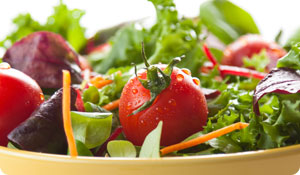
Eating a low-cholesterol, low-saturated-fat diet can go a long way in helping you manage your blood cholesterol levels (aim for a total cholesterol level of less than 200 mg/dL) and reduce your risk of having a heart attack and stroke—and it doesn't have to be boring.
There are many ways to eat a healthy diet without sacrificing taste. Here are ten suggestions on how to prepare healthy, delicious meals.
1. Reduce sodium
Consuming too much sodium can lead to high blood pressure in some people. According to the American Heart Association, it's best to limit your intake of salt to less than 1,500 mg of sodium per day. Here's how:
- Use less salt or no salt at the table and in cooking
- Use herbs and spices in place of salt
- Limit the amount of condiments you use and avoid using bacon and other cured meats
2. Reduce saturated fat in meat and poultry
Trim all visible fat from meat before cooking, and:
- Buy "choice" or "select" grades rather than "prime"
- Broil instead of frying meats
- Remove the skin from chicken or turkey before cooking
3. Make seafood at least twice a week
Fish is low in saturated fat. Instead of frying, try baking, broiling or grilling fish.
4. Reduce the amount of meat in meals
Try cooking meatless meals using vegetables. For example, place a grilled Portobello mushroom on a bun instead of a beef burger. If you must have meat, use it sparingly, just for flavor.
5. Use liquid vegetable oils instead of solid fats
Try canola, safflower, soybean, and olive oil instead of butter, lard, or shortening.
6. Substitute egg whites for whole eggs
The yolks of eggs are packed with cholesterol, but egg whites are a heart-healthy source of protein. Many recipes calling for whole eggs turn out just as good using egg whites alone or cholesterol-free egg substitutes. Just replace each whole egg with two egg whites.
7. Use Pureed fruits and vegetables in place of oil in baking
Substitute the amount of oil called for in a recipe with the same amount of pureed fruits or vegetables. For example, use applesauce in spice muffins or oatmeal cookies instead of oil.
8. Lower dairy fats
Use low-fat or fat-free milk in place of whole milk or half-and-half in recipes.
9. Reduce fat in gravies and sauces
Cool liquid after cooking and remove the hardened fat before making gravy.
10. Use vegetable spray instead of oil
Vegetable oil sprays contain just 20 percent of saturated fat. Use them to brown or sauté food.





